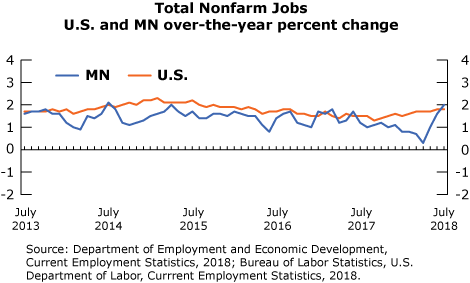by Nick Dobbins
August 2018
Monthly analysis is based on seasonally adjusted employment data. Yearly analysis is based on unadjusted employment data.*
Employment in the Minneapolis-St. Paul MSA was down by 7,838 (0.4 percent) in July. Declines are not uncommon this time of year. This was the smallest job loss for the month going back to when our records start in 1990 save for one month, July of 2016. The recent shrinking of the usual over-the-month job losses in July suggests that a shift in the seasonal pattern may be emerging. July’s declines were driven in large part by Government employment, which was off by 13,524 (5.4 percent), entirely from the Local Government Educational Services subsector (down 15,747 or 16.8 percent). Mining, Logging, and Construction employment was up by 2,157 (2.4 percent), the largest over-the-month growth of any supersector in the metro. Over the year the MSA added 43,595 jobs (2.2 percent). It was the highest over-the-year growth since July of 2014. Mining, Logging, and Construction had the largest proportional growth, up 4.8 percent (4,246 jobs) from a year prior. Leisure and Hospitality added the most new jobs, up by 9,058 (4.6 percent), with notable growth in both component sectors as Arts, Entertainment, and Recreation added 1,523 jobs (3.7 percent), and Accommodation and Food Services added 7,535 (4.8 percent). Information was the only supersector to lose jobs on the year, down 542 or 1.4 percent.
The Duluth-Superior MSA lost 1,387 jobs (1 percent) in June. While every MSA in the state lost jobs on the month, Duluth’s decline was the sharpest. Government employers led the declines, shedding 1,722 jobs (6.6 percent) thanks to a drop of 1,919 (10.8 percent) in Local Government. Leisure and Hospitality had the most growth of any supersector, adding 433 jobs (2.7 percent). Annually the Duluth MSA added 1,964 jobs (1.4 percent) in July, marking two full years of consistent over-the-year growth in the region. Manufacturers added 212 jobs (2.8 percent), Government added 611 (2.6 percent), and Other Services added 261 (3.9 percent). The only supersectors to shrink on the year were Information (down 29 jobs or 2.2 percent) and Professional and Business Services (down 66 or 0.8 percent).
The Rochester metro area lost 429 jobs (0.3 percent) in July. This was actually the best over-the-month performance of any MSA in the state. Losses in Government (down 604 or 4.5 percent) and Educational and Health Services (down 362, 0.7 percent) were mitigated in part by the addition of 297 jobs (2.5 percent) in Leisure and Hospitality and 120 jobs (2.5 percent) in Mining, Logging, and Construction, both of which outperformed statewide growth on the month. On an over-the-year basis, however, Rochester turned in the worst performance for a Minnesota MSA, adding just 424 jobs (0.3 percent). Leisure and Hospitality added 667 jobs (5.7 percent), but the vitally important Educational and Health Services supersector shed 778 jobs (1.6 percent) on the year. The supersector has lost jobs on an over-the-year basis every month in 2018, although that loss comes in comparison to a strong early 2017. Mining, Logging, and Construction also posted notable declines, down by 123 (2.4 percent) over the previous 12 months.
Employment in the Saint Cloud MSA was down by 854 jobs (0.8 percent) in July. As expected, Government employment led the decline, off by 1,150 (7.8 percent) thanks to sharp drops in Local Government. Leisure and Hospitality, which was strong across the state in July, also contracted, down by 172 jobs (1.8 percent). St. Cloud was the only MSA primarily in Minnesota in which the usually strong summer supersector lost jobs. Grand Forks-East Grand Forks also lost jobs in the supersector. On an over-the-year basis the MSA added 2,068 jobs (1.9 percent). Strong performances from Manufacturing and Educational and Health Services led the way, up 861 jobs (5.6 percent) and 881 jobs (4.2 percent), respectively. A number of supersectors lost jobs on the year, but only one, Professional and Business Services, lost more than 100 (158, 1.7 percent).
The Mankato-North Mankato MSA lost 325 jobs (0.5 percent) in July. As was the case across the state, the monthly losses were largely driven by declines in Government employment, which was off by 673 (6.7 percent). Private sector employers added 348 jobs (0.7 percent). Annually the MSA added 3,808 jobs (6.9 percent). This was the largest proportional over-the-year growth in the state, although it was driven in large part by an increase of 2,046 (27.9 percent) in Government employment which is likely to be revised downward significantly in final estimates.
Employment in the Fargo-Moorhead MSA was down by 577 (0.4 percent) in July. The loss came entirely from the Government (down 2,356 or 12.7 percent), as every other supersector added jobs on the month. The largest gain came in Leisure and Hospitality (up 721 or 5.2 percent). Annually the Fargo-Moorhead MSA added 2,008 jobs (1.4 percent). Trade, Transportation, and Utilities was the lone job loser, off by 188 (0.6 percent) on the year. Notable increases occurred in Educational and Health Services (up 862 or 3.6 percent) and Manufacturing (up 281 or 2.9 percent).
The Grand Forks-East Grand Forks MSA lost 1,840 jobs (3.2 percent) in July, by far the steepest decline of any MSA in Minnesota. Government employers led the decline, but they were joined by Other Services, Financial Activities, Educational and Health Services, and Leisure and Hospitality. Annually the MSA added 786 jobs (1.4 percent). Leisure and Hospitality added 331 jobs (5.6 percent), and Manufacturing added 241 (5.6 percent).
